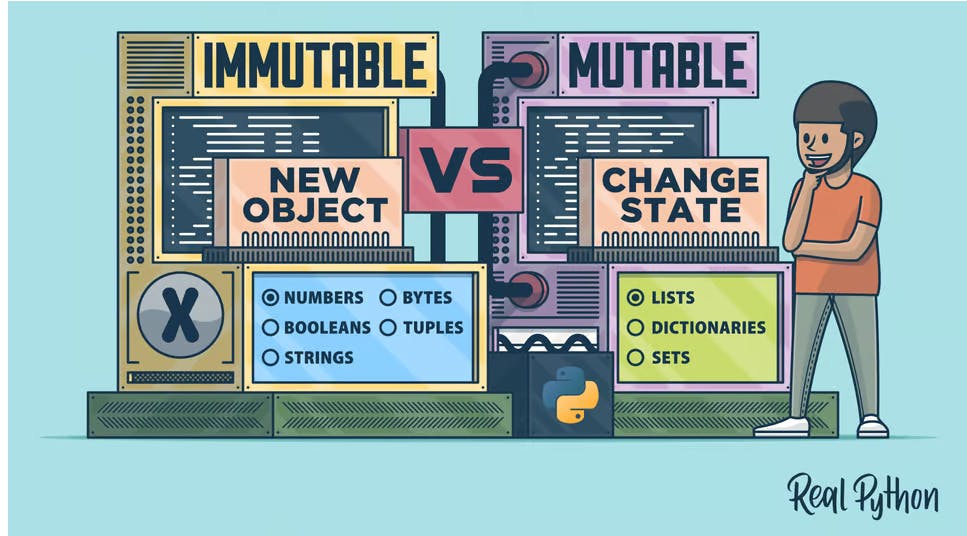Unlocking the Power of Python: Decoding Mutable vs. Immutable Types with Examples

Python, as a versatile and popular programming language, provides various data types for handling and manipulating information. One key distinction among these data types is whether they are mutable or immutable. Understanding the difference between mutable and immutable objects is crucial for writing efficient and bug-free code. In this blog post, we will delve into the concepts of mutability and immutability in Python, explore their types, discuss the advantages and disadvantages of each, and provide illustrative examples with corresponding code and output.

What are Mutability and Immutability?
Mutability and immutability refer to the ability or inability of an object to change its state after it has been created. Mutable objects allow modifications, whereas immutable objects remain unchanged once created.
Mutable Types
- Lists: Lists are ordered, mutable, and versatile data structures in Python. They can contain elements of different types and can be modified by adding, removing, or replacing elements. Lists are denoted by square brackets ([]).
my_list = [1, 2, 3]
print(my_list) # Output: [1, 2, 3]
my_list.append(4)
print(my_list) # Output: [1, 2, 3, 4]
my_list[0] = 0
print(my_list) # Output: [0, 2, 3, 4]
- Dictionaries: Dictionaries are mutable data types that store key-value pairs. They offer efficient lookup operations based on unique keys. You can modify dictionaries by adding, modifying, or deleting key-value pairs. Dictionaries are enclosed in curly braces ({}) and use a colon (:) to separate keys and values.
my_dict = {"name": "John", "age": 30}
print(my_dict) # Output: {'name': 'John', 'age': 30}
my_dict["gender"] = "Male"
print(my_dict) # Output: {'name': 'John', 'age': 30, 'gender': 'Male'}
del my_dict["age"]
print(my_dict) # Output: {'name': 'John', 'gender': 'Male'}
- Sets: Sets are mutable collections of unique elements. They are useful for removing duplicates or performing set operations such as union, intersection, or difference. Sets are defined using curly braces ({}) or the
set()constructor.
my_set = {1, 2, 3}
print(my_set) # Output: {1, 2, 3}
my_set.add(4)
print(my_set) # Output: {1, 2, 3, 4}
my_set.remove(2)
print(my_set) # Output: {1, 3, 4}
- Byte Arrays: Byte arrays are mutable sequences of integers in the range 0-255. They are used for the efficient manipulation of binary data or byte-oriented operations. Byte arrays can be modified by changing individual elements. They are created using the
bytearray()constructor.
my_bytearray = bytearray(b"Hello")
print(my_bytearray) # Output: bytearray(b'Hello')
my_bytearray[0] = 72
print(my_bytearray) # Output: bytearray(b'Hello')
my_bytearray.extend(b" World!")
print(my_bytearray) # Output: bytearray(b'Hello World!')
Pros of Mutable Objects
Mutable objects allow in-place modifications, avoiding the need for creating new objects.
They are suitable for scenarios where dynamic changes to data are required.
Mutable objects can be more memory-efficient in certain situations.
Cons of Mutable Objects
In-place modifications can lead to unexpected side effects, especially in concurrent or multithreaded environments.
Mutability can make the code harder to reason about and debug.
It is challenging to implement hash-based data structures using mutable objects.
Immutable Types
- Strings: Strings are immutable sequences of Unicode characters. Once created, you cannot modify individual characters of a string. However, you can create new strings by concatenation or using string manipulation functions.
my_string = "Hello"
print(my_string) # Output: Hello
# Attempting to modify the string will result in an error
my_string[0] = 'J' # Raises a TypeError
- Tuples: Tuples are immutable ordered collections of elements. They can contain elements of different types and are often used to represent a group of related values. Tuples are defined using parentheses (()).
my_tuple = (1, 2, 3)
print(my_tuple) # Output: (1, 2, 3)
# Attempting to modify the tuple will result in an error
my_tuple[0] = 0 # Raises a TypeError
- Integers, Floats, and Booleans: These are built-in immutable numeric and boolean types in Python. Once assigned a value, it cannot be changed.
my_integer = 5
print(my_integer) # Output: 5
# Attempting to modify the integer will result in an error
my_integer += 1 # Raises a TypeError
my_float = 3.14
print(my_float) # Output: 3.14
# Attempting to modify the float will result in an error
my_float *= 2.0 # Raises a TypeError
my_boolean = True
print(my_boolean) # Output: True
# Attempting to modify the boolean will result in an error
my_boolean = False # Raises a TypeError
Pros of Immutable Objects
Immutable objects are safer to use in concurrent or multithreaded environments as they cannot be modified.
They ensure data integrity and guarantee that the object remains in a consistent state.
Immutable objects can be used as keys in dictionaries and elements in sets.
Cons of Immutable Objects:
Creating new objects for modifications can be less memory-efficient, especially for large datasets.
Frequent creation of new objects can impact performance in certain scenarios.
Conclusion
Understanding the concepts of mutability and immutability is essential for writing efficient and reliable code in Python. Mutable objects, such as lists, dictionaries, sets, and byte arrays, allow modifications after creation, enabling dynamic changes to the data. On the other hand, immutable objects, such as strings, tuples, integers, floats, and booleans, remain unchanged once created, ensuring data integrity and simplifying concurrent programming. By being aware of the pros and cons of mutable and immutable objects, you can make informed decisions when choosing the appropriate data types for your programming tasks.